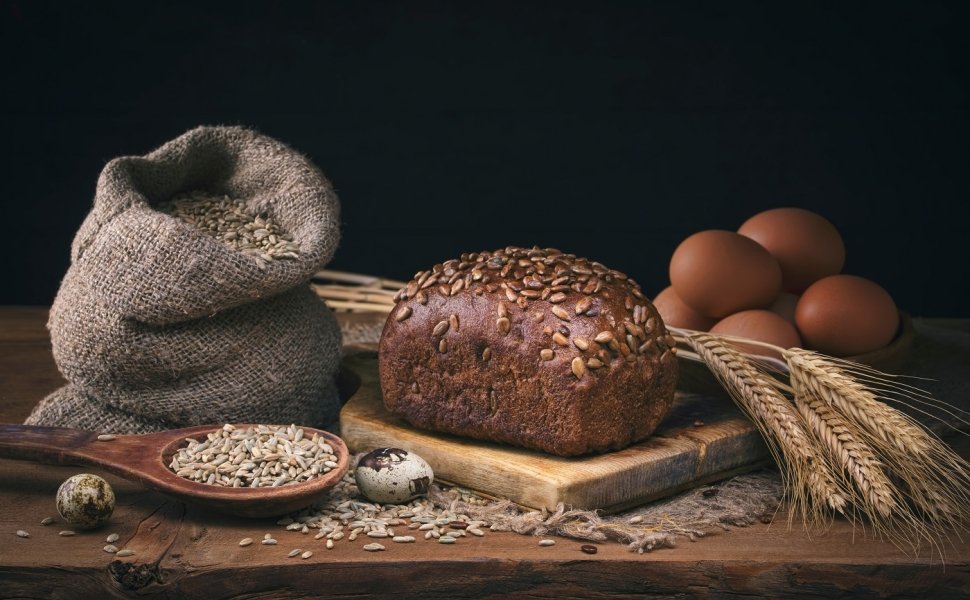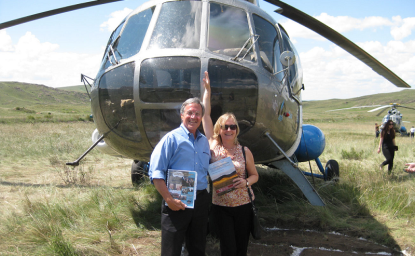This transcript has been lightly edited for clarity.
Jill Dougherty: From the Kennan Institute in Washington D.C., welcome to KennanX, a podcast on our never-ending quest to understand Russia, Ukraine and the surrounding region. I'm your host, Jill Dougherty.
***
[Violin Instrumental]
Jill Dougherty: As many of our KennanX podcast listeners know, I studied, lived, and worked in Russia for many years and food was always an issue. In the early days, back in the 1960s and 70s and then again in the early 90s—there was never enough of it. Later there was plenty, Moscow even became a food-lover’s heaven. But food in Russia and the Soviet Union before has always played an outsized role: famines, deliberate starvation of population a weapon of war.
So when I saw that Professor Darra Goldstein had come out with a new book on Russian food, I wanted to talk with her. About that food, about Russian History, and about how today, even writing about Russia or its culture has become highly political.
***
Jill Dougherty: Well, Darra Goldstein, welcome back. You've been here once and you're back again. Just for the record, as I think most of our followers know Darra Goldstein is Professor of Russian Emerita at Williams College, and she's the author of six books on cooking. And she was a guest on KennanX a while ago when her book, Beyond the North Wind: Russia in Recipes and Lore, came out. I really love that book. And you're back with another gem and this one is called, and I have it right here, The Kingdom of Rye: A Brief History of Russian Food. It's really fantastic. Welcome back.
Darra Goldstein: Thanks so much for having me, Jill. It's always a pleasure to talk to you.
Jill Dougherty: I love the way—I read the book, of course, and in the preface, I love the way I think the first line, you described Russia as a place that your family, yes: “in my family, Russia was a place to escape from,” which is a great first line. But also how you describe your fascination with food and Russia and Russian culture. Could you start with that? Where did this love start?
Darra Goldstein: I'm not sure exactly where it started. It might have started at my grandmother's knee when I was really small and she was baking rugelach, which are a typical Jewish pastry that are rolled and filled with cinnamon and nuts usually. And it had nothing to do with Russia really, except that when I started studying Russia and looking into Russian cuisine, I realized that these were actually Russian and also Ukrainian pastries, rogaliki, which mean little horns or crescents.
So, there was a connection between her very difficult childhood in Vitebsk in what is now Belarus, it was part of the Russian empire. And my maternal grandfather came from Ukraine. And they would never say anything about their life in the past. So of course, it made me curious. And I began to study Russian in college, partly because I loved languages and I already had studied German and French, and I wanted a different language group. So, Russian seemed like the one to study. And, something about the language really grabbed me. And we started reading stories particularly by Chekhov and Gogol, and these stories were just filled with food. And as I write in the book, something unusual happened in that I was reading–my Russian wasn't that good at that point—but somehow the passages about food I could understand, on I want to say a gut level, a visceral level, even before I even knew the exact foods. And then I would go back and look things up. So that really began my love affair with the culinary aspect of Russia.
Jill Dougherty: Oh, wow. And I know we have a similar background in that we were both guides on U.S. Information Agency exhibits in the old Soviet Union, many years ago. You were on agriculture, and then it was interesting the way you described, Soviet food is not exactly famous for its delicious nature. However, you said that Russian hospitality changed your impression of Russian food. Do you want to go into that a little bit?
Darra Goldstein: It really did Jill, and in fact it, it saved me and my study of things Russian, working on Agriculture USA. I was there in 1978, 1979 was an extraordinary experience. As you remember, we were like celebrities in these cities we visited. But it was intrinsically problematic as a subject. It wasn't like design or photography, which were more material objects. Food is sustenance, and there was a good dose of propaganda. We had early videos of American grocery stores showing how you could get tomatoes trucked in from California in the middle of winter, and the American housewife could have any tomatoes she wants. Of course, we look at it now, we're horrified because we know what those tomatoes tasted like, but still they were there. And many of the foods we were showing in our displays of canned goods and preserves, were not available to Russians.
But they had this intense pride and they would bring me homemade preserves. They would bring me homemade goodies and to show that they were also able to do something. And, besides that, I went against State Department rules in that I wasn't supposed to go out with Russians, but I was there to learn about Russia, to learn about Russian life. So when people took great risk and invited me to their apartments, I went. And they fed me incredibly well, even though the stores were basically empty. So it was that paradox of Soviet life. How did you eat when there was nothing to be had? And part of the reason for this book was really to untangle the complications of Soviet life. To show the ingenuity of Russians, how to obtain things, but also how to turn, I think I used the phrase “culinary straw” into gold. Taking ingredients that aren't intrinsically interesting and turning them into something really delicious.
Jill Dougherty: Yeah. Well, what I love about the book is that you say it is a brief history of Russian food. It is a small book. It's a lovely size, I must say, I really physically like the way it's put together with that beautiful picture on the front. But I guess I wanted to ask: Rye of course - when I think of Russia, I think of borodinsky khleb, my favorite black bread, just pungent, moist, damp, almost, and heavy and fantastic. But let's start with rye. Why is it so key to Russian cuisine?
Darra Goldstein: Partly because it's such a hearty grain. So, Russia if you think of it in geographic terms, it is very northerly, most of the land mass is in very cold climate. And also, the soil isn't particularly rich. So, until modern hybrids of wheat were developed, wheat didn't thrive there except in the very southern parts of Russia. And rye—which was originally discovered as a weed growing in southwest Asia—farmers noticed that where other grains were dying around it, this rye was really hardy. So it came to Russia or the Russian lands in about the 10th century, which is fairly late when you think about it. And it, it literally took hold.
And the other part of that is that, because it became a ubiquitous grain in addition to millet, which was also grown a bit more in the south, but oats were very widespread and also barley. Rye has a chemical structure that its sugar, its starches break down more slowly than the starches, say, in wheat do. So it, it keeps you sated for longer. And if you're a peasant or a serf, let's start with the serfs, before the peasants. Laboring long in the fields, never enough to eat—the rye would keep you full a bit longer.
Jill Dougherty: That's very interesting. You mentioned that Russian culinary culture responds to hardship, and so there appear to be some commonalities. You mentioned sour is one thing. Which really is true when I think about it, I kind of thought, yes, she's absolutely right! What are the other, you know, basic, unique features of Russian food or cuisine?
Darra Goldstein: Well, I think sour really is the predominant one. That pucker that you get, the tang, whether it's through something like sauerkraut or pickles that have been lacto-fermented. So, they're not prepared in vinegar. Whether you have some of the wonderful berries like sea buckhorn that is really tangy or lingonberries, these northern berries that also provide that bread, the borodinsky that you mentioned—the traditional bread—The rye bread is lacto-fermented. It's a sourdough. So again, you have that sour taste.
Jill Dougherty: I just wanted to jump in. So, lacto-fermented, you can lacto-ferment anything? I mean bread, pickles?
Darra Goldstein: Well, the bread, you, you make the sourdough. So, the sourdough is the lacto-fermentation. So, you add the sourdough to the flour and water, and that is the chemical process that occurs.
Jill Dougherty: Oh, okay.
Darra Goldstein: So, you can lacto-ferment, all kinds of vegetables, you can make kvass which is another good example. It is the ur-Russian drink, I would say. And it's made by taking stale bread, allowing it to soften with some water and then taking that mash, allowing that to ferment, and you often add honey or some herbs and it becomes a slightly alcoholic, probably only two percent, very nicely effervescent drink. And the Russians have this saying, whereas we say, “eating from hand to mouth,” if you're barely surviving, they say from “bread to kvass.” So, it's this eternal cycle. They would also add the brine from pickles again, the salt brine pickles to soups.
So a wonderful Russian soup like rassolnik, if you ever had that, which has as its basis the word rassol, which means brine. It is basically a meat soup that has pickle brine in it. So, it's just repeated throughout the cuisine. But I would also say there's a taste for the sweet and sour. That is often accomplished by very slow cooking that draws out flavors. So, you might braze onions, say with a little bit of, with a little bit of honey you could add, the onions will caramelize as they cook and become sweeter, and that becomes a nice accompaniment to a blander dish.
Jill Dougherty: You mentioned honey several times just in the last couple of minutes, and I am a huge honey freak. And I remember when I was living in Moscow for quite a long time, the mayor at the time, Mayor Lushkov, was a big honey person. In fact, I think he actually made honey. And he had a honey fair and I used to go to that. It was downtown in a big exposition hall and you could see honey from all over Russia: white, black, yellow, liquid some that looked like butter that you had to cut with a knife. It was really fascinating. So what's the deal with honey?
Darra Goldstein: I love talking about honey. Russia was really famous for its honey and they're still holding those festivals all over the country, so it's, it's not simply, you probably saw it VDNKH. There is a honey pavilion there that has a lot of educational material. But the northern swath of Russia is covered with taiga, which is this boreal forest. And the early travelers left tales of these wild beehives in the trunks of the trees and just swarming with bees and honey in great pools. And they're certainly apocryphal tales of people falling into the pools and not being able to get out because the honey is so sticky.
Jill Dougherty: That’s a nice death.
Darra Goldstein: A sweet death, we might say, yes. But they fermented that honey. Because again, here's that fermentation, that's the leitmotif, and they turned it into mead. Which is a honey wine. And the Russians particularly the monasteries were quite famous for the different meads that they made. Honey was a great export, as was beeswax for candles. And until the late 19th century, honey was the primary sweetener. So, all of the jams that they made, all of the different kinds of preserves used honey instead of sugar. And one of the things I tried to do when I was developing the recipes for “Beyond the North Wind,” I really have a sweet tooth, I have to admit. But I was trying really hard not to use sugar in the book, but to use honey. And I snuck a little bit of sugar in, but for the most part honey adds another dimension of flavor, of course it's very healthy. It has a lot of antibacterial properties.
Jill Dougherty: Yes. As the women used to tell me, I would go around and they would have a little like stick that you could, try the different ones and they would say, this is good for your liver, or, this is good for your stomach, but absolutely. There's so much here, we could talk forever. But I just wanted to say the other thing about this book is it's educational, it's history, it's about food, but also your writing - like I came, I just note this on page sixteen, where you say this - burbot. I had to look up what a burbot fish is, number one, because I pronounced it in my head as “berbeau.” [sic]
Darra Goldstein: Oh, you had too much French.
Jill Dougherty: “Berbot liver was especially prized for the unctuousness it lent to soups and pies.” It sounds like a poem, but anyway, fantastic writing! But could we go through, there’s obviously that Soviet period. And then we get up to today, which I think is quite interesting. I remember at least a decade ago, seeing more and more Russian products and I would buy them. They were very interesting. You mentioned oats. I eat a lot of oatmeal. They had natural packaging, you know, getting back to tradition. Can you tell me a little bit about this modern Russian food – the return to that?
Darra Goldstein: Yeah, at the moment it's such a painful story, but for a while it was quite exhilarating. So after the collapse of the Soviet Union there was tremendous economic chaos and there wasn't food in the stores. Again, people were having to rely on their own personal gardens to grow potatoes just to survive. But at the same time, there was this huge influx of foreign goods, foreign foods, and it was fancy packaging, very bright and colorful things that people had only heard about but never been able to taste and everyone wanted something foreign.
But after a few years, there was a recognition that, well, we can do things too. And people started looking back to their own traditions and one of the prime movers in this, I guess we could call it a movement, is a guy named Boris Akimov who started in, I think it was 2009, a company called Lafka Lafka. Which means “shop,” like a little shop, it can mean a counter. And he started trying to find ways to connect farmers and artisanal producers with consumers. So he set up a little shop where he was selling farm to consumer, and it was in this beautiful natural packaging that you're talking about. And it spoke very deeply to the Russian land.
And there was definitely a degree of nostalgia to it, but it was also a resurrection of foods that had been nearly lost in the 70 years of Soviet rule. They had just disappeared. He was studying old cookbooks and things like that. And then he opened a couple of cafes. And there really was this movement and it was all well and good and new restaurants opened. They weren't foreign, but were also focused on Russian foods. Then Russia invaded Crimea in 2014 and annexed Crimea, and sanctions were placed against Russia because of their terrible actions. And in response, Russia announced counter-sanctions, meaning that no foods would be imported from the EU, the US, Canada, Australia, Norway. And suddenly all this wealth of foreign foods dried up and the Russians had become particularly fond of cheese. They just went mad for cheese. Hard cheeses had never been part of the Russian tradition. They're really good at making soft cheeses, the cottage cheeses like tvorog and things like that.
So suddenly, what to do? And they started imitating these foreign cheeses and making extraordinary domestic versions of them. So you can get Russian brie, you can get Russian feta, Russian gouda and it's all produced in Russia. But they also, it really jump-started a strong movement to eat Russian. The difficult part of this story is that that movement to eat Russian became heavily tinged with a kind of ugly nationalism. So, there was a group that was going into stores and denouncing stores if they found foods that had foreign labels, foods that were being smuggled in across the border.
Tons, like hundreds of tons of foods were destroyed by bulldozers, even though it could have been distributed to charities or orphanages. It was really quite awful. Especially given Russians’ history with hunger and often starvation. And the discourse became very nationalistic. There was a vodka that was introduced in 2013 called Valenki, those wonderful Russian felt boots. They're the warmest things you can imagine wearing. And they're also symbolic of old Russian peasant culture. And so the bottle had, you know, a boot on the, on the label, but in a special export edition of its production, it had a, what they called a patriotic neck hanger to make the bottle more visible on the shelves. And it said, “We were in Paris” referencing, you know, the Napoleonic Wars. “We were in Berlin,” referencing World War II. “We will be in New York.” So yeah, it was horrific. So, it was playing on, you know, what is deeply Russian, you know, the snow and felt boots, but also this other highly nationalistic rhetoric. And you saw that even on candy bars. And now in the current situation with the sanctions against Russia and the terrible situation. I can't even find words really to describe it. The nationalism is again at the fore.
Jill Dougherty: I noticed you have a photograph, you have several photographs in the book, and one of them shows woman in a food market, which I presume is kind of the trend that you're talking about. And she has that thing on her t-shirt says: “Esch’ Rossiskoye.” So, “Eat Russian.” But it's interesting, she did not say “Russkoye” she said, “Rossiskoye” which is the more political word for Russian. We don't have to get into etymology. But that definitely is, I think a very let's say political statement by that woman.
Speaking of things that are a little negative, I understand you've had some difficulty with this book just because it is about Russian food.
Darra Goldstein: It is about Russian food. I wouldn't say it's a glorification of Russian food. It's a celebration of Russian ingenuity through hardship. But hardship is a good third of the book. I mean, one of the chapters is titled “Hunger and Hardship.” And what I tried to do in the book is give a very balanced view of Russian life through the lens of food and showing how from the very beginning, most of the population was hungry, most of the year. How they struggled to have enough to eat and how they managed. And a lot of that struggle had to do with not just the climate and the difficulties of living in a place where you have a very short growing season. But also the repeatedly, continuously cruel governments that the Russians have had to endure.
I talk about how lack of government intervention, or intentional government intervention led to the worst famines of the 20th century. Including the collectivization of Ukraine and the seizing of the very rich farmland and the killing of millions and millions of Ukrainian farmers, the so-called “kulaks” and the displacement of others. And that happened in the early 1930s. Something that Putin is just following right from Stalin's playbook in using food as a weapon of war.
So, there's a history to be gleaned here that I think reveals what is resilient about the Russians, what is beautiful about their culture, but also not shying away from what is abhorrent about it. I mean, it's very complicated. Obviously for any of us who, at any time have kind of fallen in love with the wonderful parts of Russia and then you're brought up short by thinking about all that is truly awful. And I think it's certainly exacerbated now.
Jill Dougherty: Yes. Well, historically Russians have, I mean, over centuries have talked about that dichotomy the love hate-relationship. But certainly, with food, as you put it, “at a time when tensions once again divide Russia and the West, cultural understanding becomes all the more crucial.”
And I think for anybody who does love food and healthy food. This, as I looked at this, I thought maybe I should have more pickled things, because a lot of these things are very healthy besides being wonderfully delicious. So, thank you very much for, you know, for writing this book and such a fantastic history because it is food as you pointed out, really is connected to very directly to the history of Russia.
Darra Goldstein: I just want to urge you to make sure to eat lacto-fermented pickles and not pickles that have been preserved in vinegar because they won't offer the same health benefits.
Jill Dougherty: Wow. I hope I can find them.
Darra Goldstein: Oh, you can.
Jill Dougherty: Darra Goldstein, again, thank you so much for coming back on KennanX, and very good luck with your book which is fantastic, again The Kingdom of Rye: A Brief History of Russian food. Thank you.
Darra Goldstein: Thank you so much for talking with me, Jill.
***
KennanX is a product of the Kennan Institute at the Woodrow Wilson International Center for Scholars in Washington, D.C. It is the Wilson Center’s oldest program, founded in 1974 by George F. Kennan, American statesman, James Billington, historian and former Librarian of Congress, and historian S. Frederick Starr. Inspired by them, the Kennan Institute’s mission is to improve America’s understanding of Russia and the wider region. Thanks for listening.









